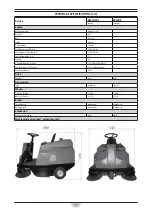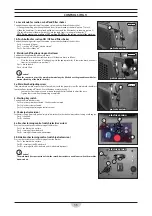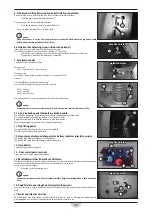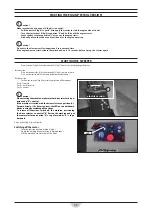
46
REFUSE BIN (FIG.17)
A
B
1
C
Fitting the refuse bin
To fi t the bin, keep its front part raised and push with
a foot until completely goes into its.
The rear edge “A” of the bin must fi t into the two up-
per slides “B and the pins “C” on the slots as shown in
picture. Engage the closing hook 1.
In this position, the bin is perfectly airtight.
!
Caution!
Periodically check the condition of the
gaskets set up between the container and
the chassis.
B
ELECTRIC SYSTEM “ELECTRIC VERSION” (FIG.18)
The electrical system operates at 36 V and is powered by six 6V - 180Ah batteries 1.
Never continue operating the machine until the batteries run completely flat.
The indicator 2 shows the battery charge level, where as the status regarding autonomy and charge is
provided in real-time. The charge is interrupted in due time, thereby preventing deep discharges that would
damage the battery.
An electronic hourmeter on the indicator displays the number of operating hours of the machine.
A - Hourmeter
Indicates the working hours of the machine.
B - LEDs
The LEDs indicate the charge of the battery.
If the LEDs are all lit, the battery is fully charged.
As the battery gradually discharges, the LEDs go off . The battery charge is low when the penultimate
yellow LED flashes (next to the red LED) and the battery must be charged.
If the last red LED is lit, the battery is flat and all the operating functions of the machine are disabled.
Recharge the battery:
• Switch
off the machine and remove the key.
•
Disconnect the plug 4 from the socket 3.
•
Connect on the plug 4 the connector the external battery charger.
•
The batteries are ready to be recharged.
C – Battery type selector switch
The selector switch is used to set the type of battery:
•
Set the selector switch on pos.1 if Lead-Acid Batteries are to be used.
•
Set the selector switch on pos.4 if Gel batteries are to be used.
•
(See section, OPTIONAL - BATTERY CHARGER ON BOARD)
D - Connector
Battery maintenance
Keep the batteries dry and clean. Pay particular attention to the terminals and terminal bolts.
At intervals depending on how much the motor-sweeper is used, check the level of the electrolyte. Top up
with distilled water if necessary.
Periodically check the effi
ciency of the battery charger.
Make sure that the area in which the battery is charged is well ventilated. Keep naked fl ames well away from
the battery, especially while it is being charged.
Autonomy
The motor-sweeper has a working autonomy of about 4 hours.
Perform the following checks if autonomy drops below this value:
•
Check that the brush is not pressing too hard on the fl oor.
•
Check that there is no string or wire, etc., entangled in or around the main brush which
might cause friction and increase power consumption.
•
Check that the battery is fully charged when you start work.
0 1
2
3
4
5
6
7
1
2
3
4
5
6
7
8
A
B
C
D
anteriore | front | avant
vordere | parte delantera | voorzijde
posteriore | rear | arrière
Rückseite | parte trasera | achterzijde
2
1
3
4
















































